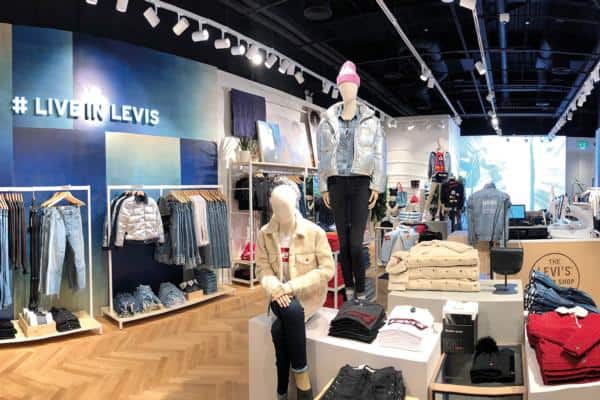A fifth of Levi’s sales took place online in the third quarter of its financial year, as shoppers bought more directly from the brand and bought more online.
Direct-to-consumer sales grew by 34% in the quarter to August 29, compared to the same time last year, and by 4% compared to the third quarter of 2019, while digital sales grew by 10% on last year, and by 76% on 2019. In total, 20% of Levi Strauss & Co’s net revenues of $1.5bn (£1.1bn, +41% on 2020 and +3% on 2019) took place online. Wholesale revenues were up by 45% on the same time last year, and by 3% on the same time in 2019. Net income for the quarter reached $193m (£141.6m) up from $27m (£19.8m) a year earlier.
The brand also bought Beyond Yoga for about $400m (£293.4m), taking it into the activewear market, where sales have grown quickly during the pandemic and the move to working from home.
“We delivered a strong quarter with revenue growth versus pre-pandemic 2019 levels, despite a more difficult macro-environment than we expected,” says Chip Bergh, president and chief executive of Levi Strauss & Co. “These results reflect the strength of the Levi’s brand, improving momentum in our direct-to-consumer business and the scale and agility of our supply chain network where we have executed against macro-headwinds exceptionally well.”
During the quarter, around 10% of Levi’s own stores were closed as a result of Covid-19 lockdowns – and around 20% its stores in Asia. Around 4% of stores are closed at the moment.
In Europe, net revenues for the third quarter were ahead of the same time in 2020. Compared to the same period in 2019, they grew by 7%, while online sales grew by 41%. Growth in wholesale (+3%) was driven by digital pureplays, and direct-to-consumer sales grew by 12%. Overall, net revenues through all digital channels in Europe were 87% ahead of 2019, and represented 24% of Levi Strass sales in the region.
Commeting, Pippa Stephens, retail analyst at GlobalData, says: “Levi’s DTC proposition has been hindered by its own website, which comprised only 6% of total revenue for the latest quarter. Its delivery options are inferior to those offered by many of its wholesale partners, dissuading shoppers from buying direct, so it must improve these to be more affordable and efficient. However, it has been significantly investing in its own physical stores, integrating experiential concepts including repair and customisation services, which will have helped to boost footfall upon reopenings.
“Levi’s focus on sustainability helps to give it an advantage over many of its competitors as consumers become more environmentally conscious, with new initiatives regularly being announced by the company. In September 2021, it launched pop-ups in nine Nordstrom stores and online in collaboration with three designers, which used old Levi’s products to create new garments, while this month it also announced that it will begin using a new plant-based indigo dye in its denim, further highlighting its commitment to reducing its environmental impacts.
“Going forward, it should emphasise the ethical credentials of the business more too, especially as recent scandals in the fashion industry have brought to light the poor conditions often experienced by garment workers. With many other retailers increasing their transparency as a result, Levi’s should include more details about where each item is made on tags and online product pages, as this will help it to increase shoppers’ confidence in the brand.”
Levi’s is a Top350 retailer in RXUK Top500 research.









